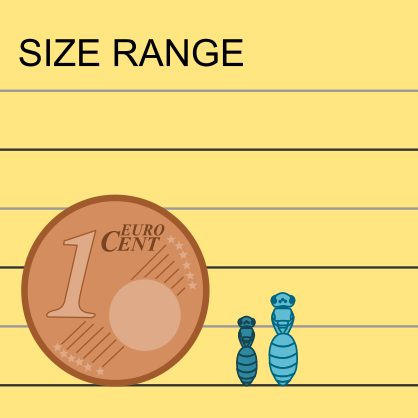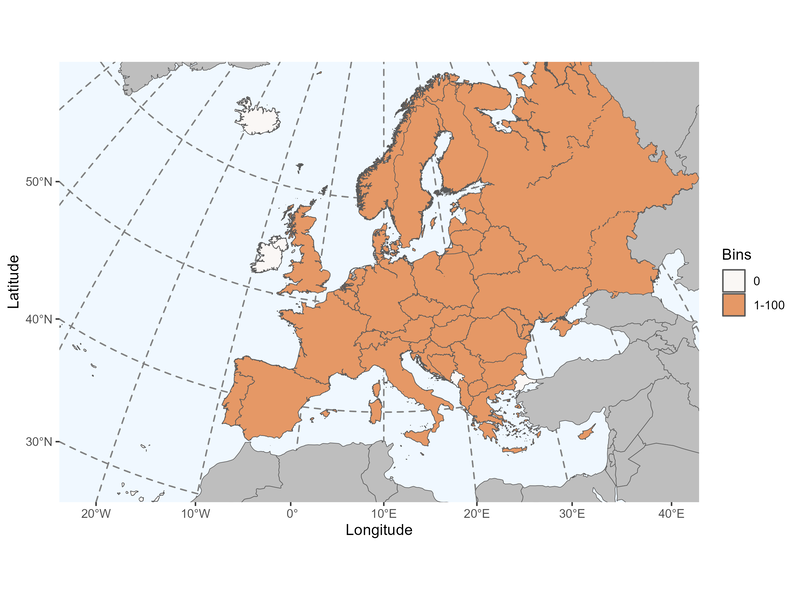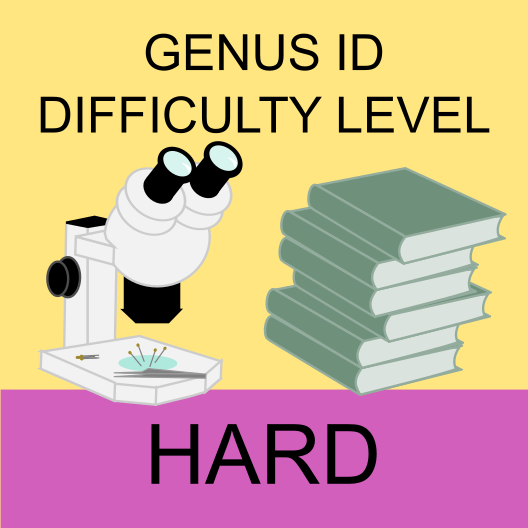Author: Spinola, 1808
|
Type species: Apis truncorum Linnaeus, 1758, designated by Latreille, 1810: 439.
Subgenera: Heriades s.str. Spinola, 1808; Michenerella Krombein, 1950; Rhopaloheriades Griswold and Michener, 1998. Synonyms: Eriades Dalla Torre and Friese, 1895; Trypetes Schenck, 1861. |
Clade: Anthophila
Family: Megachilidae SubF: Megachilinae Tribe: Osmiini |
|
Distinctive traits
|
Pictures of distinctive traits.
(Sorry, there is no picture available at this time. If you have some and would like to become a contributor to IDmyBee, please contact us.) |
Morphologically close genera and how to distinguish them
Hofferia species have rounded axillae.
Stenoheriades species have a long proboscis extending beyond its fossa at rest. The mandible is bidentate.
Chelostoma, Haetosmia, Hoplitis & Osmia don't have a transverse carina on T1 and have rounded axillae (except for axillae of Osmia (Hoplosmia)).
Protosmia species have a carinated propodeal triangle. Some don't have a transverse carina on the T1.
- Heriades - Hofferia
Hofferia species have rounded axillae.
- Heriades - Stenoheriades
Stenoheriades species have a long proboscis extending beyond its fossa at rest. The mandible is bidentate.
- Heriades - Chelostoma, Haetosmia, Hoplitis & Osmia.
Chelostoma, Haetosmia, Hoplitis & Osmia don't have a transverse carina on T1 and have rounded axillae (except for axillae of Osmia (Hoplosmia)).
- Heriades - Protosmia
Protosmia species have a carinated propodeal triangle. Some don't have a transverse carina on the T1.
General comments on Heriades species identification
Females can be diagnosed by the structure on the clypeus apex and labrum, best seen with open mandibles.
Identification criterion in males are located on the last tergites, sternites and genitalia.
Females can be diagnosed by the structure on the clypeus apex and labrum, best seen with open mandibles.
Identification criterion in males are located on the last tergites, sternites and genitalia.
Sorry, but the species identification tool is not yet available for Heriades.
Please check the reference(s) below for traditional keys.
Please check the reference(s) below for traditional keys.
List of the 5 Heriades species found in Europe (Ghisbain et al. 2023):
Heriades (Heriades) crenulata Nylander, 1856
Heriades (Heriades) rubicola Pérez, 1890
Heriades (Heriades) truncorum (Linnaeus, 1758)
Heriades (Michenerella) punctulifera Schletterer, 1889
Heriades (Rhopaloheriades) clavicornis Morawitz, 1875
Heriades (Heriades) crenulata Nylander, 1856
Heriades (Heriades) rubicola Pérez, 1890
Heriades (Heriades) truncorum (Linnaeus, 1758)
Heriades (Michenerella) punctulifera Schletterer, 1889
Heriades (Rhopaloheriades) clavicornis Morawitz, 1875
References with identification keys for some of the species:
- Benoist R. 1929. Les Heriades de la faune française (Hym. Apidae). Annales de la Société entomologique de France, 98: 131-141.
- Amiet, F., Herrmann, M., Müller, A., & Neumeyer, R. (2004). Apidae 4: Anthidium, Chelostoma, Coelioxys, Dioxys, Heriades, Lithurgus, Megachile, Osmia, Stelis. Fauna Helvetica 9. Centre suisse de cartographie de la faune (CSCF), Neuchâtel 273pp.
- Falk S.J. (2015) Field Guide to the Bees of Great Britain and Ireland. Bloomsbury wildlife guides. 432 p.
Online resources:
Palearctic Osmiine Bees (Palearctic)
BWARS (UK)
Exotic Bee ID (World)
Discover Life (World)
WestPalBees (West Palearctic)
Palearctic Osmiine Bees (Palearctic)
BWARS (UK)
Exotic Bee ID (World)
Discover Life (World)
WestPalBees (West Palearctic)
Page contributors:
You noticed a mistake? You have a suggestion to improve this page?
Don't keep it to yourself, please contact us and become a contributor to IDmyBee!
- Adrien Perrard (Dec. 2023)
- Adrien Perrard (Dec. 2019)
You noticed a mistake? You have a suggestion to improve this page?
Don't keep it to yourself, please contact us and become a contributor to IDmyBee!
References used to write this page:
- Ghisbain, G., Rosa, P., Bogusch, P., Flaminio, S., Le Divelec, R., Dorchin, A., Kasparek, M., Kuhlmann, M., Litman, J., Mignot, M., Müller, A., Praz, C., Radchenko, V.G., Rasmont, P., Risch, S., Roberts, S.P.M., Smit, J., Wood, T.J., Michez, D. & Reverte, S. (2023). The new annotated checklist of the wild bees of Europe (Hymenoptera: Anthophila). Zootaxa, 5327(1), 1-147.
- Michener, C.D. 2007. The Bees of the World, 2nd Edition. The John Hopkins University Press, Baltimore.
- Michez D., Rasmont P., Terzo, M., Vereecken, N. 2019. Abeilles d'Europes. Hymenoptères d'Europes, Volume 1. N.A.P. Editions.
- Nieto, A., Roberts, S. P., Kemp, J., Rasmont, P., Kuhlmann, M., García Criado, M., ... & Michez, D. 2014. European red list of bees. Luxembourg: Publication Office of the European Union, 98.
- Rasmont, P., Devalez, Jelle, Pauly, A., Michez, D. & Radchenko, V.G. 2017. Addition to the checklist of IUCN European wild bees (Hymenoptera: Apoidea). Annales de la Société entomologique de France 53: 17-32.



